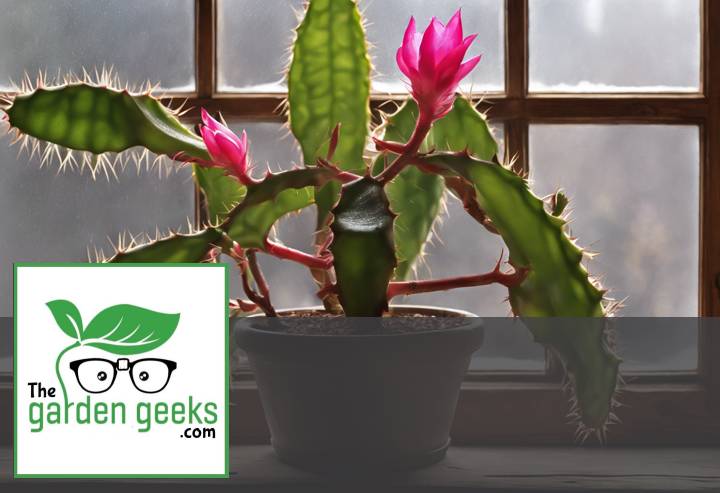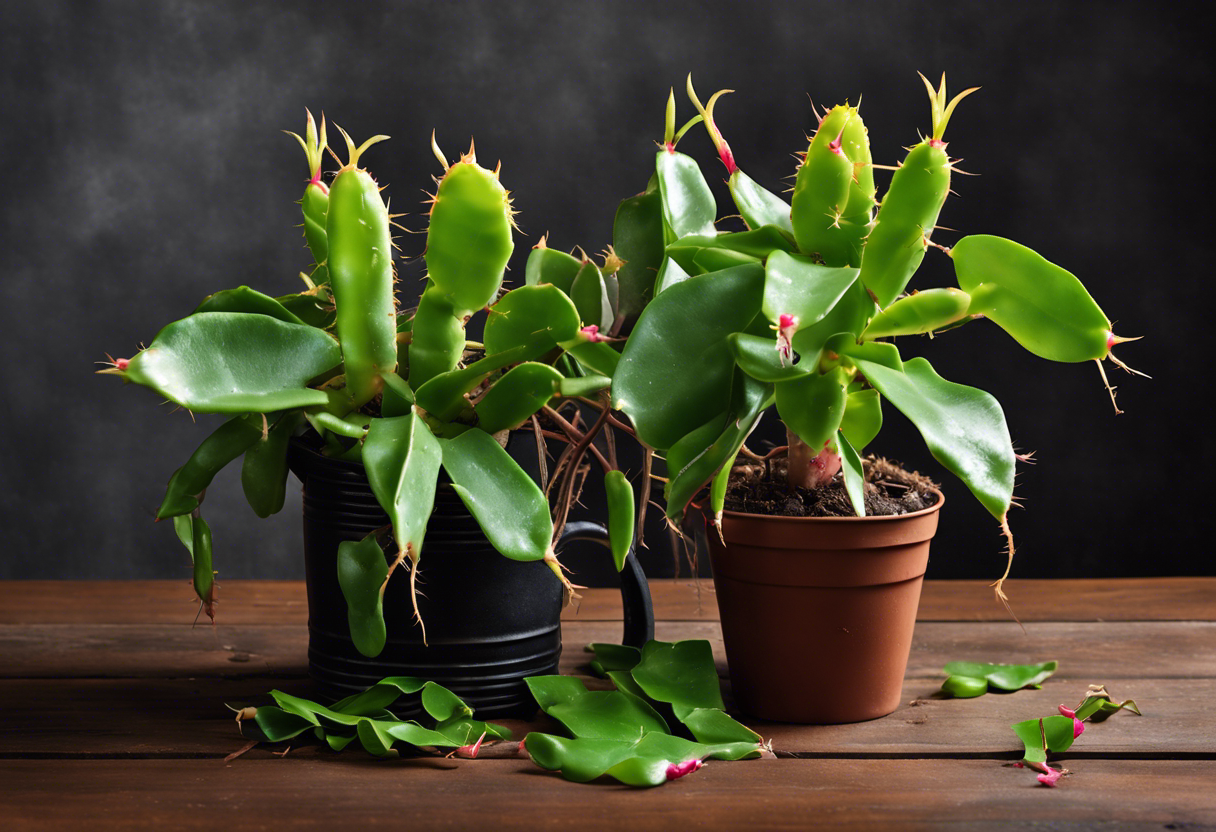Well, hello there green thumbs! Ever wondered why your Christmas Cactus Isn’t Blooming? You’re not alone. I’ve been there, staring at my cactus, willing it to bloom with all the festive spirit of Santa’s workshop… but nada.
Don’t fret though. It’s not you; it’s just that Christmas cacti can be a bit diva-ish sometimes. They need their conditions just right before they decide to put on a show. So let’s dive into the 7 reasons why your Christmas Cactus isn’t blooming and how we can coax them back into their radiant glory. Keep reading for some blooming good advice!
Key Takeaways
- Your Christmas Cactus may not be blooming due to incorrect lighting conditions, as they require bright but indirect light.
- Overwatering or underwatering can also prevent blooming; these plants prefer a moist environment, but not waterlogged.
- The plant might be stressed due to sudden changes in temperature or location.
- Lack of nutrients, particularly phosphorus, can hinder blooming.
- The cactus could be too young or too old to bloom.
- Incorrect pruning techniques can damage the plant and prevent flowering.
- Finally, the plant may need a period of rest with cooler temperatures and reduced watering before it will bloom.
1. Inadequate Light Exposure
When it comes to Christmas cactus care, light plays a pivotal role. If your Christmas Cactus Isn’t Blooming, it could be due to inadequate light exposure. This indoor plant requires specific light requirements for Christmas cactus to bloom beautifully.
1.1 Understanding the Importance of Light for Christmas Cactus
Light is like the secret sauce in grandma’s recipe – it makes everything better! For plants, especially the Christmas cactus, light triggers photosynthesis, which is basically their food-making process. Without enough sunlight, your cactus might just decide to go on a diet and skip blooming altogether.
But here’s the kicker: too much light can also be harmful! The right balance of indoor plant light exposure is crucial for optimal growth and blooming. So if you’ve been wondering why your cactus isn’t putting up a show, maybe it’s time to check if it’s getting enough rays or not!
1.2 Identifying Signs of Inadequate Light Exposure
Now you might ask, “How do I know if my Christmas cactus isn’t getting enough light?” Well, there are some telltale signs that your green buddy might be craving more sunshine.
First off, if your cactus starts looking a bit pale or discolored, that’s a red flag right there! It’s like when we get pale from lack of sunlight during winter months (minus the freezing cold). Also, if new growth appears thin or weak, that’s another sign of insufficient lighting.
So keep an eye out for these symptoms and remember – a happy cactus equals beautiful blooms!
Incorrect Watering Practices
When it comes to Christmas cactus care, proper watering is a big deal. It’s like the secret sauce in your grandma’s famous spaghetti recipe – get it wrong, and you’re in for a disappointment. In this case, your Christmas Cactus Isn’t Blooming because of some watering hiccups.
The Role of Water in Christmas Cactus Blooming
Now, let’s talk about why water is so important for your Christmas cactus. You see, water plays a crucial role in the cactus bloom cycle. It helps transport essential nutrients to different parts of the plant, promoting healthy growth and flowering.
But here’s the kicker: too much or too little water can disrupt this process. That’s right! Your Christmas cactus needs just the right amount of hydration to bloom properly. So if you’ve been wondering why your Christmas cactus blooming has been off lately, improper watering could be the culprit.
Common Mistakes in Watering Christmas Cactus
So what are these common mistakes that lead to blooming issues? Well, first up is overwatering. Yes, even though water is essential for plant hydration, too much of it can cause root rot and prevent blooming.
On the flip side, underwatering isn’t any better either. When there’s not enough water, your plant can’t transport nutrients effectively which affects its ability to bloom. These are just some examples of how incorrect watering practices can mess with your Christmas cactus’ blooming game.
Remember folks: when it comes to watering your Christmas cactus, balance is key!
3. Lack of Proper Temperature Conditions
Temperature plays a crucial role in your Christmas Cactus care. If your Christmas Cactus Isn’t Blooming, it might be due to improper temperature conditions. Let’s dive into the nitty-gritty of temperature requirements for blooming and how extreme temperatures can affect your plant.
3.1 Ideal Temperature for Christmas Cactus Blooming
The ideal temperature for Christmas Cactus blooming is between 60-65 degrees Fahrenheit during the day and around 50-55 degrees at night. This mimics the natural environment where these plants thrive, providing optimal blooming conditions.
Maintaining this temperature range is part of proper indoor plant temperature requirements. It encourages the plant to produce buds and eventually bloom. So, if you’re wondering why your cactus isn’t showing any flowers, check your thermostat!
3.2 Effects of Extreme Temperatures on Blooming
Now, let’s talk about what happens when things get too hot or cold. Extreme temperatures can have detrimental effects on your Christmas Cactus.
High temperatures can cause stress to the plant, potentially preventing Christmas Cactus bloom altogether. On the flip side, extremely low temperatures can damage or even kill the cactus.
That’s why it’s essential to protect your plants from these extremes as part of effective indoor plant care. Remember, maintaining proper temperature is key to keeping that Christmas spirit alive with a blooming cactus!
Insufficient Humidity Levels
Humidity is like the secret sauce in your grandma’s famous recipe. It’s a key ingredient for your Christmas cactus care. You see, these plants are native to humid, tropical rainforests. So, when they’re stuck in our dry living rooms, they can struggle to bloom.
Why Humidity Matters for Christmas Cactus Blooming
Now let’s get into the nitty-gritty of why humidity is so important for Christmas cactus blooming. These plants are like drama queens; they need the right environment to put on their show of blooms.
Without adequate humidity levels, they might just refuse to perform! It’s all about creating the perfect indoor jungle vibe that mimics their natural habitat.
Remember those indoor gardening tips you read about? Well, maintaining proper humidity is one of them!
Recognizing Symptoms of Low Humidity
So how do you know if your Christmas cactus is throwing a tantrum due to low humidity? Look out for signs like wilting or shriveling leaves – it’s their way of saying “I’m parched!”
Another symptom could be slow growth or no blooming at all. If your Christmas Cactus Isn’t Blooming, it could be screaming for more moisture in the air.
Don’t worry though! With a bit of tweaking and some good old plant TLC (tender loving care), you can get those humidity levels just right and have your Christmas cactus blooming in no time!
Poor Fertilization Techniques
If your Christmas Cactus Isn’t Blooming, it might be due to poor fertilization techniques. Just like us humans, plants need a balanced diet too! And in the world of Christmas cactus care, this means proper fertilizing.
Importance of Fertilization for Bloom Production
Now, you might be wondering why fertilizing is so important. Well, it’s simple! Proper fertilization plays a key role in bloom production. It provides your Christmas cactus with the nutrients it needs to produce those beautiful blooms we all love.
But here’s the kicker – overdoing it can have the opposite effect. Too much fertilizer can actually hinder bloom production. So, if you’ve been heavy-handed with the feed and your Christmas cactus blooms are nowhere to be seen, this could be why.
How to Correctly Fertilize Your Christmas Cactus
So how do you avoid these poor fertilization effects? By using correct fertilization techniques, of course! The secret sauce for optimal blooming is a balanced fertilizer that’s high in potassium and phosphorus but low in nitrogen.
When applying fertilizer, less is more. You want to give your plant just enough food without overwhelming it. Remember, we’re aiming for Goldilocks levels of feeding here – not too much, not too little, but just right!
And finally, timing is everything. The best time to fertilize is during the growing season (April to October). After that period, give your plant a break from feeding so it can focus on producing those stunning blooms.
So there you have it folks! If your Christmas Cactus Isn’t Blooming, check your fertilizing habits first. With some tweaks and patience, you’ll soon see those gorgeous flowers popping up!
Absence of Dormancy Period
A key reason why your Christmas Cactus Isn’t Blooming could be the absence of a dormancy period. This crucial phase in the Christmas cactus care routine is vital for its blooming cycle and overall plant health, especially in indoor gardening.
Understanding the Dormancy Period in a Christmas Cactus Life Cycle
The dormancy period, or what you might call the plant’s beauty sleep, is an essential part of the Christmas cactus life cycle. It’s when our green friend takes a breather from growing, responding to seasonal changes like shorter days and cooler temperatures.
This break isn’t just about being lazy though! It’s a strategic pause that prepares the cactus for its next big show – blooming! So, no dormancy period equals no flowers. Bummer, right?
Implementing a Dormancy Period for Your Plant
Creating a dormancy period at home isn’t as tricky as it sounds. Start by reducing water and withholding fertilizer around fall to mimic nature’s cues.
Next, move your plant to a cooler spot with less light – think “winter conditions”. Remember not to go overboard though; we’re aiming for restful sleep, not hibernation!
Presence of Pests or Disease
Another culprit behind your non-blooming Christmas cactus could be pesky pests or diseases. These unwelcome guests can wreak havoc on your plant’s bloom production and overall health.
How Pests and Diseases Affect Bloom Production
Pests and diseases are like tiny Grinches stealing your Christmas cactus blooms! They damage plant tissues, disrupt nutrient absorption, and cause stress – all bad news for blooming.
Common offenders include root rot (too much love with water there!) and fungal infections (think plant flu). Both can seriously hamper bloom production.
Identifying and Treating Common Pests and Diseases
Spotting pests and diseases early is half the battle won. Look out for signs like yellowing leaves, wilting, or unusual spots.
Once identified, treatments can range from simple remedies like reducing watering to using specific pest control products. Remember, when in doubt, it’s always a good idea to consult with your local nursery or plant doctor!
To Wrap Up
In a nutshell, your Christmas Cactus Isn’t Blooming because it’s as fussy as a toddler at bedtime. It needs just the right light, temperature, and watering schedule to show off its festive flowers.
So, don’t despair! With these tips in mind, you’ll have your Christmas cactus blooming brighter than your holiday lights in no time. Happy gardening!





